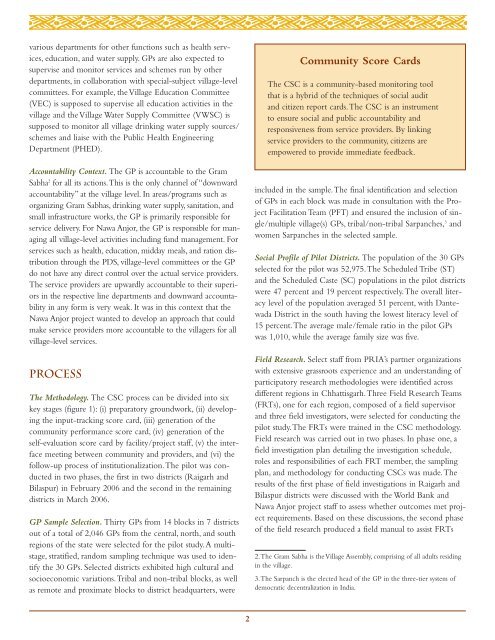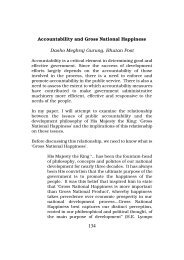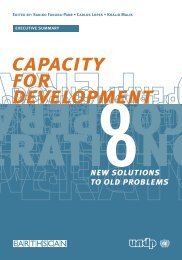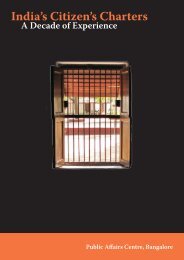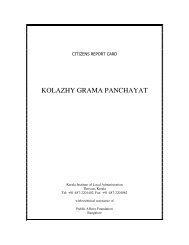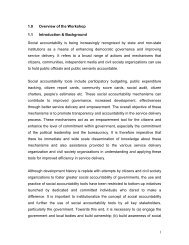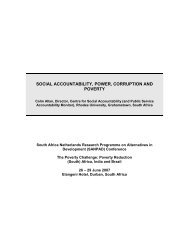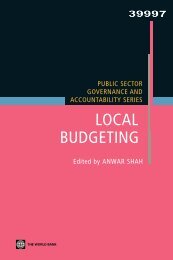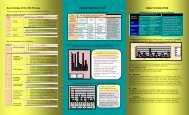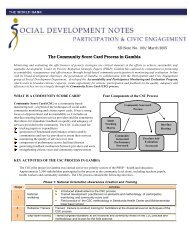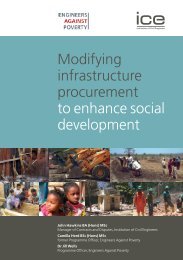Community Score Cards - SASANet
Community Score Cards - SASANet
Community Score Cards - SASANet
- No tags were found...
You also want an ePaper? Increase the reach of your titles
YUMPU automatically turns print PDFs into web optimized ePapers that Google loves.
various departments for other functions such as health services,education, and water supply. GPs are also expected tosupervise and monitor services and schemes run by otherdepartments, in collaboration with special-subject village-levelcommittees. For example, the Village Education Committee(VEC) is supposed to supervise all education activities in thevillage and the Village Water Supply Committee (VWSC) issupposed to monitor all village drinking water supply sources/schemes and liaise with the Public Health EngineeringDepartment (PHED).Accountability Context. The GP is accountable to the GramSabha 2 for all its actions.This is the only channel of “downwardaccountability” at the village level. In areas/programs such asorganizing Gram Sabhas, drinking water supply, sanitation, andsmall infrastructure works, the GP is primarily responsible forservice delivery. For Nawa Anjor, the GP is responsible for managingall village-level activities including fund management. Forservices such as health, education, midday meals, and ration distributionthrough the PDS, village-level committees or the GPdo not have any direct control over the actual service providers.The service providers are upwardly accountable to their superiorsin the respective line departments and downward accountabilityin any form is very weak. It was in this context that theNawa Anjor project wanted to develop an approach that couldmake service providers more accountable to the villagers for allvillage-level services.PROCESSThe Methodology. The CSC process can be divided into sixkey stages (figure 1): (i) preparatory groundwork, (ii) developingthe input-tracking score card, (iii) generation of thecommunity performance score card, (iv) generation of theself-evaluation score card by facility/project staff, (v) the interfacemeeting between community and providers, and (vi) thefollow-up process of institutionalization.The pilot was conductedin two phases, the first in two districts (Raigarh andBilaspur) in February 2006 and the second in the remainingdistricts in March 2006.GP Sample Selection. Thirty GPs from 14 blocks in 7 districtsout of a total of 2,046 GPs from the central, north, and southregions of the state were selected for the pilot study. A multistage,stratified, random sampling technique was used to identifythe 30 GPs. Selected districts exhibited high cultural andsocioeconomic variations.Tribal and non-tribal blocks, as wellas remote and proximate blocks to district headquarters, were<strong>Community</strong> <strong>Score</strong> <strong>Cards</strong>The CSC is a community-based monitoring toolthat is a hybrid of the techniques of social auditand citizen report cards.The CSC is an instrumentto ensure social and public accountability andresponsiveness from service providers. By linkingservice providers to the community, citizens areempowered to provide immediate feedback.included in the sample.The final identification and selectionof GPs in each block was made in consultation with the ProjectFacilitation Team (PFT) and ensured the inclusion of single/multiplevillage(s) GPs, tribal/non-tribal Sarpanches, 3 andwomen Sarpanches in the selected sample.Social Profile of Pilot Districts. The population of the 30 GPsselected for the pilot was 52,975.The Scheduled Tribe (ST)and the Scheduled Caste (SC) populations in the pilot districtswere 47 percent and 19 percent respectively.The overall literacylevel of the population averaged 51 percent, with DantewadaDistrict in the south having the lowest literacy level of15 percent.The average male/female ratio in the pilot GPswas 1,010, while the average family size was five.Field Research. Select staff from PRIA’s partner organizationswith extensive grassroots experience and an understanding ofparticipatory research methodologies were identified acrossdifferent regions in Chhattisgarh.Three Field Research Teams(FRTs), one for each region, composed of a field supervisorand three field investigators, were selected for conducting thepilot study.The FRTs were trained in the CSC methodology.Field research was carried out in two phases. In phase one, afield investigation plan detailing the investigation schedule,roles and responsibilities of each FRT member, the samplingplan, and methodology for conducting CSCs was made.Theresults of the first phase of field investigations in Raigarh andBilaspur districts were discussed with the World Bank andNawa Anjor project staff to assess whether outcomes met projectrequirements. Based on these discussions, the second phaseof the field research produced a field manual to assist FRTs2.The Gram Sabha is the Village Assembly, comprising of all adults residingin the village.3.The Sarpanch is the elected head of the GP in the three-tier system ofdemocratic decentralization in India.2


